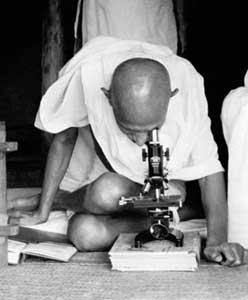"Far horizons": no AIDS vaccine today
Top: Bill Clinton and Bill Gates, both of whom head foundations which make AIDS a high priority, and also tend to favor technological solutions; since leaving office, Clinton's own choices have suggested more strongly than ever that political expediency drove his AIDS decisions in office. Bottom: George Bush plugs a cord into a prototype hybrid electric-hydrogen car.
Ten years ago today, on May 18th, 1997, President Clinton called on scientists to develop a vaccine to prevent HIV infection, and to do it within ten years:
“My fellow Americans, if the 21st century is to be the century of biology, let us make an AIDS vaccine its first great triumph.”
Clinton compared this presidential goal to President Kennedy’s “moon shot.” But this year, we mark the date knowing that Clinton’s goal was not reached, and won’t be any time soon.
When Clinton made his speech I’d just started working as a community educator for an HIV vaccine research group. The next year, some of my fellow community educators and I started marking the date with media briefings, community forums, and other outreach events. When we started the idea of marking the date each year, public relations people from the National Institute of Allergy and Infectious Diseases resisted it. “We don’t like timelines,” I remember one saying.* No wonder. Vaccine scientists have been saying that an HIV vaccine might be about ten years away for about twenty years now.
I was deeply committed to the cause of HIV vaccine research. (I still am.) At the time, I thought holding the government to a timeline was just fine. What I also knew then, and understand even more clearly now, is that although Clinton’s pledge was inspiring and important, it was also a political dodge.
During the same time that President Clinton was calling for an AIDS vaccine, he was refusing to take leadership to support needle exchange, which he and his scientific advisors knew would prevent HIV infections immediately, and not just ten years from then. And until the end of his administration, he supported international trade rules that made it impossible for poor people living with HIV and AIDS to get generic versions of life-saving medicines.
We can keep supporting the HIV vaccine effort even as we understand that there are more immediate things we can do about AIDS today. But today, let’s mark the anniversary of Clinton’s speech by looking back to another recent presidential call for a new technology:
“I ask you to take a crucial step and protect our environment in ways that generations before us could not have imagined. In this century, the greatest environmental progress will come about not through endless lawsuits or command-and-control regulations, but through technology and innovation. Tonight I'm proposing $1.2 billion in research funding so that America can lead the world in developing clean, hydrogen-powered automobiles.”
That’s George Bush, in his 2003 State of the Union address. He’s making the same gesture that Clinton made in 1997, although with a much less eloquent speech and an even more egregious policy context. In both cases, these presidents made bold calls for new technology that didn’t (and doesn’t) yet exist, as a way of avoiding political choices they didn’t want to make. AIDS means talking about sex and drugs; AIDS means realizing that “free trade” isn’t free. And global warming means making tough changes today, rather than waiting for a hydrogen car to let us keep living the exact same lives we have today but with water vapor coming out the exhaust pipe.
This similarity between the two presidential speeches suggests that this is not a problem of Democrat or Republican tactics: it’s a common mistake in American politics generally.
Bill Clinton’s AIDS vaccine speech was really a more broad-ranging speech about science and technology, made at a black university in the same week that he apologized on behalf of the US government for the Tuskegee Experiment. In his broader discussion of science, two of Clinton's sentences that sound like political throw-away lines turn out to be the key to understanding the whole speech. These two sentences illustrate how Americans get ourselves in trouble when we look to technology to save us from politics:
“We have always believed, with President Thomas Jefferson, that freedom is the first-born daughter of science. With that belief and with willpower, resources, and great national effort, we have always reached our far horizons and set out for new ones.”
Thomas Jefferson or not, nothing about this is true. Freedom is not the daughter of science: science is the daughter of freedom. And as this anniversary reminds us, we actually quite often fail to reach “our far horizons”; and having failed, we sometimes never get around to setting out for new ones. Asking engineers and scientists to solve a political problem with new technology does not require willpower, significant resources, or great national effort; it is an act of avoiding all of the above.
Most of all, when we look to science to bring us freedom from responsibility to make difficult social and political changes, we tarnish the value of science, and the importance of freedom.
______________________
* NIAID now coordinates observances for the day and puts on its own PR effort. The anniversary created its own momentum that was hard for any PR person to resist. And in the absence of startling scientific progress, there was no other regularly predictable news angle for the vaccine development effort.





1 comment:
This is a strong and telling essay, and I like the way it takes the medical issue and generalizes from it. Now how do we get the politicians to love cheap and free social solutions even though they are not highly profitable to any campaign contributors? The campaign to have everyone change one incandescent lightbulb to a compact flourescent uses both techno and participatory approaches.... I wonder how it is going?
Post a Comment